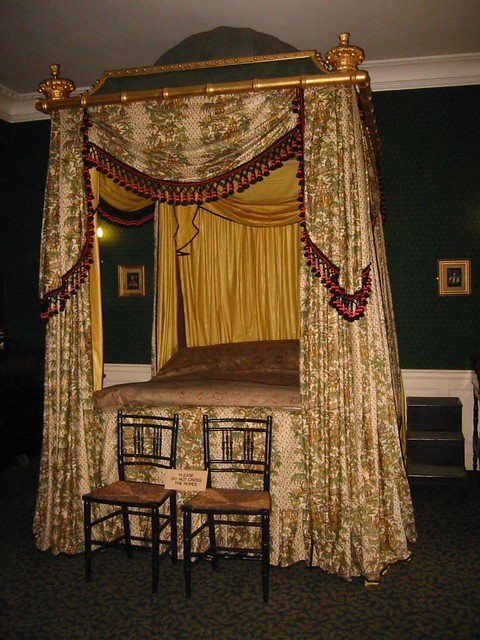 |
| Byron's bed at Newstead Abbey |
The poet Byron was born in London in 1788. He was lame, born with a club foot. Much of his early childhood was spent in Scotland where he was tended by a nurse whose encouragement of physical affection was reputedly one of the factors in his later attitude to women.
He moved to Nottinghamshire at the age of 10 when he inherited the family home, Newstead Abbey, on the death of his great uncle. He was privately educated in Nottingham and later sent to Harrow before gaining a place at Trinity College, Cambridge. He spent just a term there (although he returned to complete his studies later) before moving to London and spending much of the family money on entertainment, leaving him in serious debt. That was one of the driving forces behind his decision to publish his writings.
Newstead was unfit for living at the time Byron inherited and it was not until 1809 that he was finally able to move in. It soon became the base for many of Byron's notorious wild exploits. In the Great Hall, for example, all the fittings had been stripped (including the fireplace) by the previous Lord Byron in a bid to pay off his debts. George (the poet) Byron could not afford to restore them so he used the room for pistol practice.
Byron was a notorious womaniser, surrounded by scandal for much of his early life. His affairs were widely known, one of the most public being that with Lady Caroline Lamb. Her intense fixation with him, even after he had tired of her, was such an embarrassment that her family had her shipped off to Ireland to get her away from him. Among the tricks she tried to entice him back to her bed was to send him her pubic hair! It was she who dubbed the poet "mad, bad and dangerous to know" in one of her diaries.
In a bid to overcome the notoriety of his many affairs Byron married in 1815 and within a year the association had produced a daughter, Augusta Ada. But the marriage was doomed and in 1816 Byron moved permanently abroad. His womanising continued in Europe. In Italy he had a love affair with a married woman, the Countess Teresa Guicciolo. Her husband summoned her home and Byron followed, eventually becoming a friend of her family.
Later he developed an interest in the Greek war of independence against the Turks and raised a private army with a donation of £4,000 aid the fight. While in Messolonghi, Greece in 1824 he caught a fever, which killed him. His body was returned to England and he is buried next to his daughter in St Mary Magdalene Church, Hucknall, Nottinghamshire.









